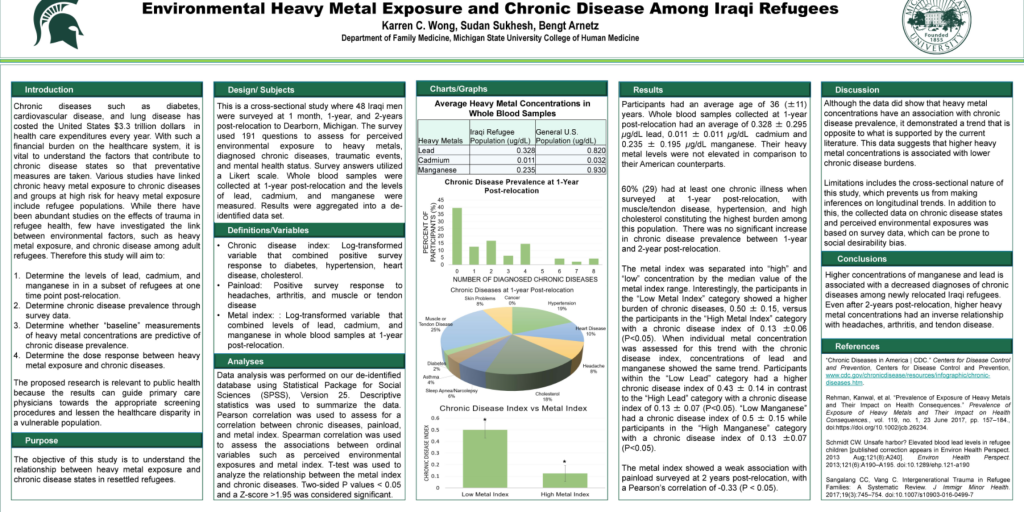2020 Blake Smith Award: Environmental Heavy Metal Exposure and Chronic Disease Among Iraqi Refugees
by Karren Wong, MS4
The purpose of this study is to assess the relationship between heavy metal exposure and chronic disease prevalence among newly resettled Iraqi refugees. This study found that higher concentrations of heavy metals (such as lead, manganese, and cadmium) in whole blood samples of Iraqi refugees were associated with higher cholesterol levels. Lead and manganese levels showed a dose-dependent response with chronic disease prevalence when participants were surveyed after one year of relocation to the United States. Environmental exposure to heavy metals continue to be a major public health concern in developing nations because of the complex interplay between rapid industrialization and insufficient environmental legislation. It is pertinent to understand the relationship between heavy metal exposure and chronic disease prevalence in order to better serve this vulnerable population.
Intro:
Many studies involving refugee health have focused primarily on the effects of trauma exposure, but few studies have assessed the role of environmental exposures on chronic disease states. Environmental exposure to heavy metals continues to be a major public health concern in developing nations because of the complex interplay between rapid industrialization and insufficient environmental legislation. According to the Pew Research Center, there are approximately 3 million refugees from these developing nations that have resettled in the United States since 1980. It is pertinent to understand the correlation between heavy metal exposure and chronic disease, especially when there is a significant refugee population in the United States. The purpose of this study is to assess the relationship between heavy metal exposure and chronic disease among resettled Iraqi refugees.
Methods:
Iraqi refugees (n = 48) were surveyed at three separate time points: 1 month, 1 year, and 2 years after relocating to the United States. The survey assessed for perceived environmental exposure to heavy metals, chronic diseases, traumatic events, and mental health status. The survey data was analyzed in conjunction with heavy metal exposure, which was measured through whole-blood samples collected at 1-year post-relocation. Metals of interest were combined to form the variable called “metal index”, which included cadmium, manganese, and lead. SPSS was utilized to assess for relationships between heavy metal exposure and chronic disease states using Pearson’s correlation and independent samples t-test.
Results:
47 out of 48 (97.9%) of participants had at least one environmental exposure prior to relocation to the United States. The heavy metal levels had a weak association with painload surveyed at 2 years post-relocation, with a Pearson’s correlation of -0.33 (P <.05). Painload was defined as positive survey responses for headaches, arthritis, and muscle tendon diseases. An independent samples t-test was conducted to compare high cholesterol levels and heavy metal levels. There was a significant difference in heavy metal levels in participants that had high cholesterol versus those that did not have high cholesterol (P=.01). Higher manganese and lead levels had a statistically significant association with chronic diseases surveyed at 1-year post relocation (P<.05).
Conclusion:
Heavy metal levels in whole blood samples of Iraqi refugees was associated with high cholesterol levels. Lead and manganese levels showed a dose-dependent response with chronic disease prevalence.
- Anyanwu, Brilliance, et al. “Heavy Metal Mixture Exposure and Effects in Developing Nations: An Update.” Toxics, vol. 6, no. 4, 2018, p. 65., doi:10.3390/toxics6040065.
- Mamtani, Ravinder, et al. “Metals and Disease: A Global Primary Health Care Perspective.” Journal of Toxicology, vol. 2011, 2011, pp. 1–11., doi:10.1155/2011/319136.




